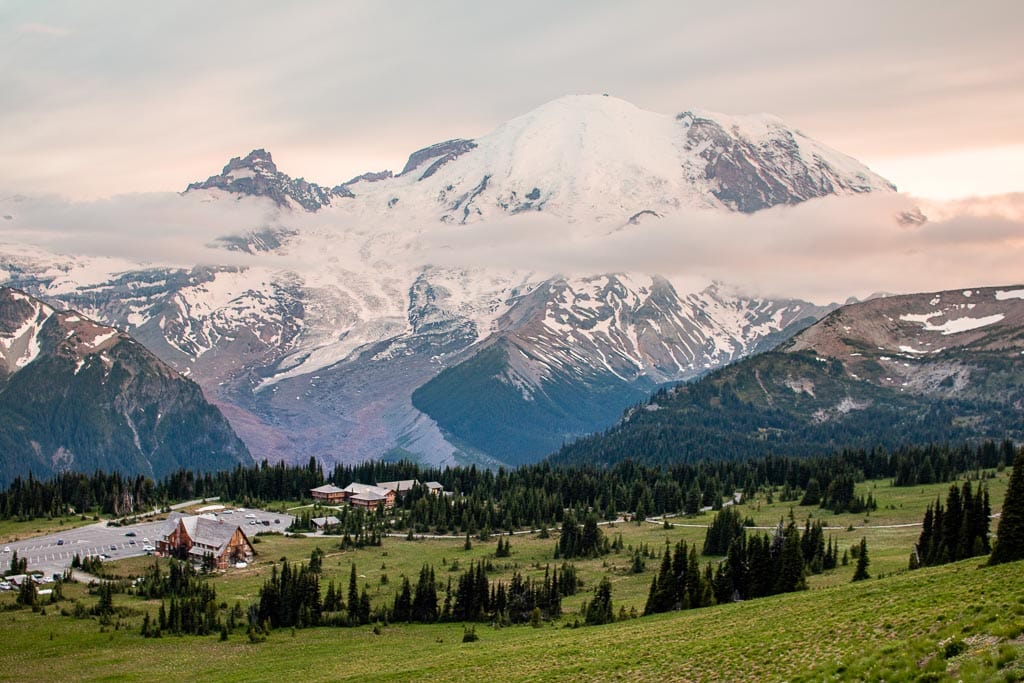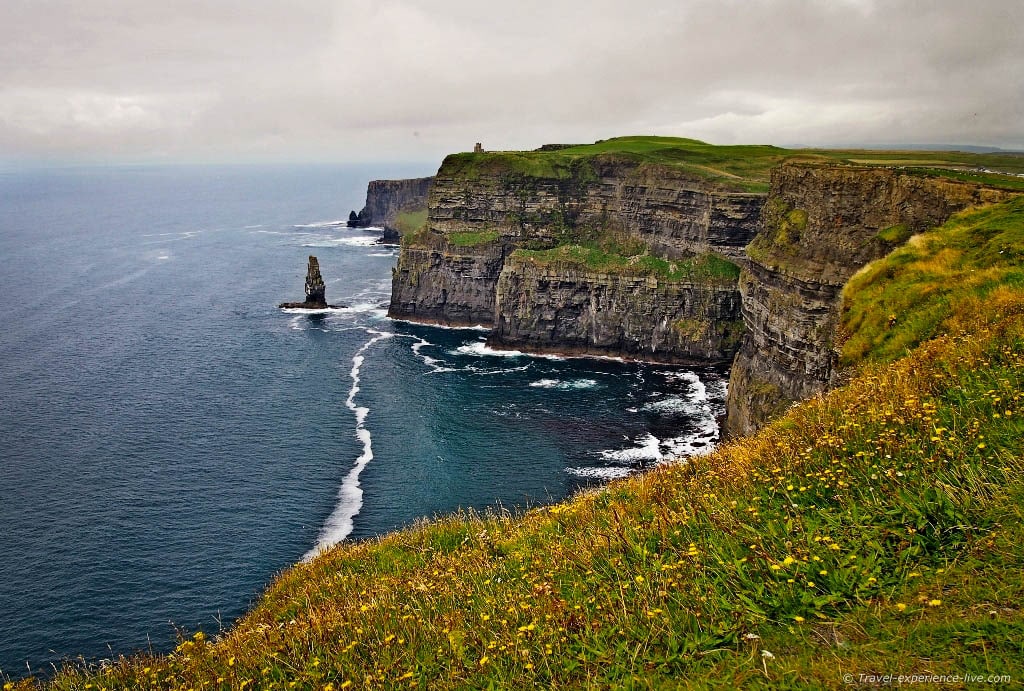10 Amazing Places to See Mount Rainier in Its Namesake National Park
Rising 14,410 feet toward the often-cloudy Pacific Northwest sky, Mount Rainier dominates the landscape in western Washington State.
This mighty mountain is so prominent that it’s an integral part of the skyline of Seattle (on clear days). Even as far south as Portland, Oregon, you can enjoy views of Mount Rainier from certain locations.
The namesake and centerpiece of Mount Rainier National Park, Mount Rainier is an active volcano. With more than 25 glaciers, it’s the most glaciated mountain in the lower 48 states.
Mount Rainier is the highest peak in the entire Cascade Range, which also includes other volcanoes like Mount St. Helens and Mt. Hood. Its summit is often shrouded in clouds, but on those rare blue-sky days, which often occur in summer, it’s a sensational sight.
Enjoy Epic Views of Mount Rainier from These 10 Locations in Its Namesake National Park
If you are looking for the best viewpoints to see Mount Rainier in the national park itself, you’ll find them below. The nicest views of Mount Rainier are mainly in two popular areas: Paradise and Sunrise.
These high-elevation locations are at or above the tree line. They’re home to expansive alpine meadows that offer spectacular, unobstructed Mount Rainier views.
Some views of Mount Rainier can be enjoyed from roadside pullouts, while others require a short walk. Additionally, there are also a number of amazing hiking trails at Mount Rainier that offer up-close views of The Mountain—sometimes so close it seems as if you could touch it.
1. Reflection Lakes (Stevens Canyon Road)
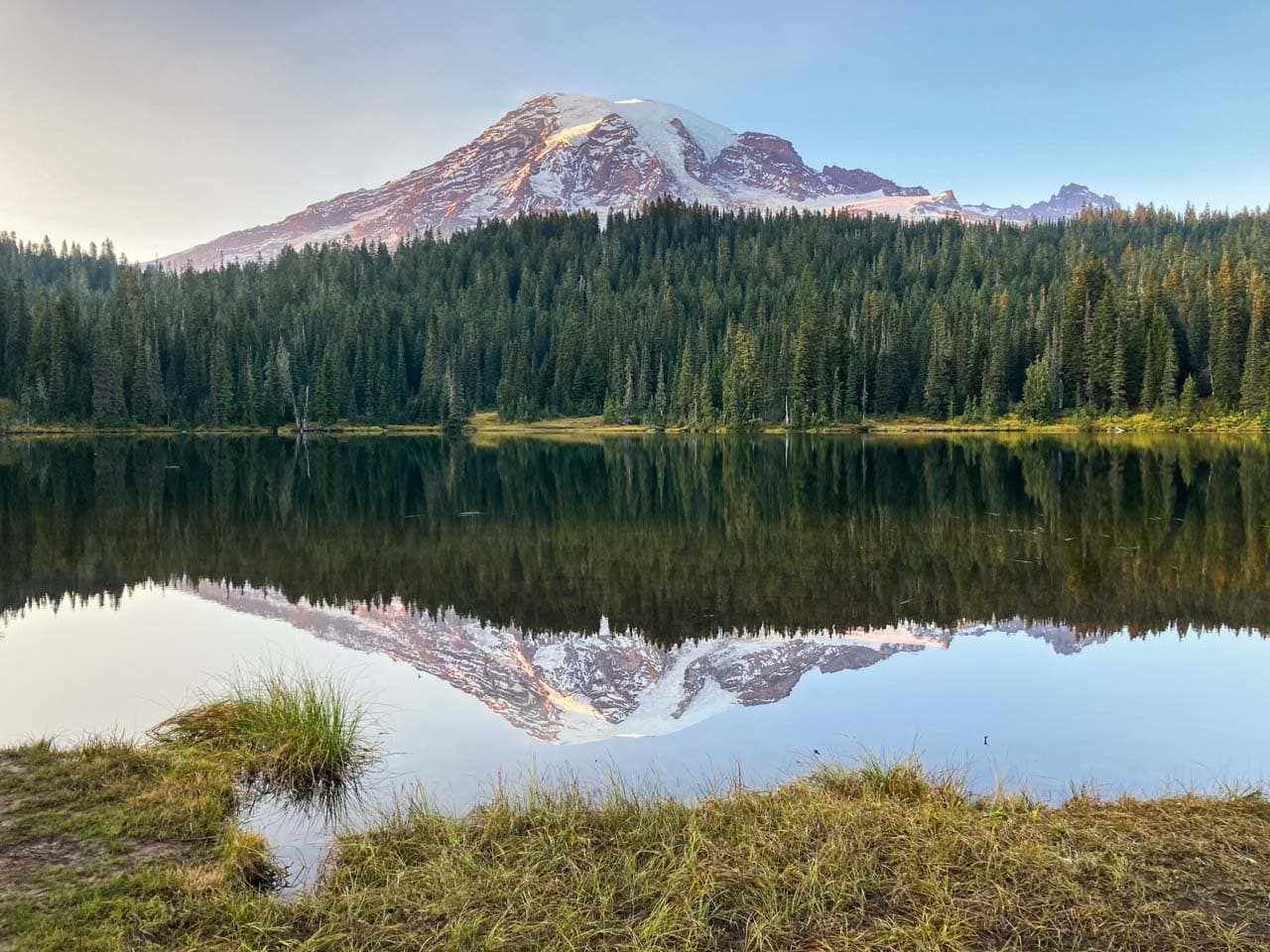
About 3 miles east of Paradise on the Stevens Canyon Road, the Reflection Lakes offer the chance to—as their name suggest—see the reflection of Mount Rainier in the water.
For this to happen, though, it needs to be a clear day with calm weather. Dawn and dusk in summer and early-fall are the best times to see reflection views of Mount Rainier at this beautiful location.
You can simply park at one of the parking lots along the road and walk down to the water’s edge for gorgeous photo ops.
2. Pinnacle Peak Trail (Stevens Canyon Road)
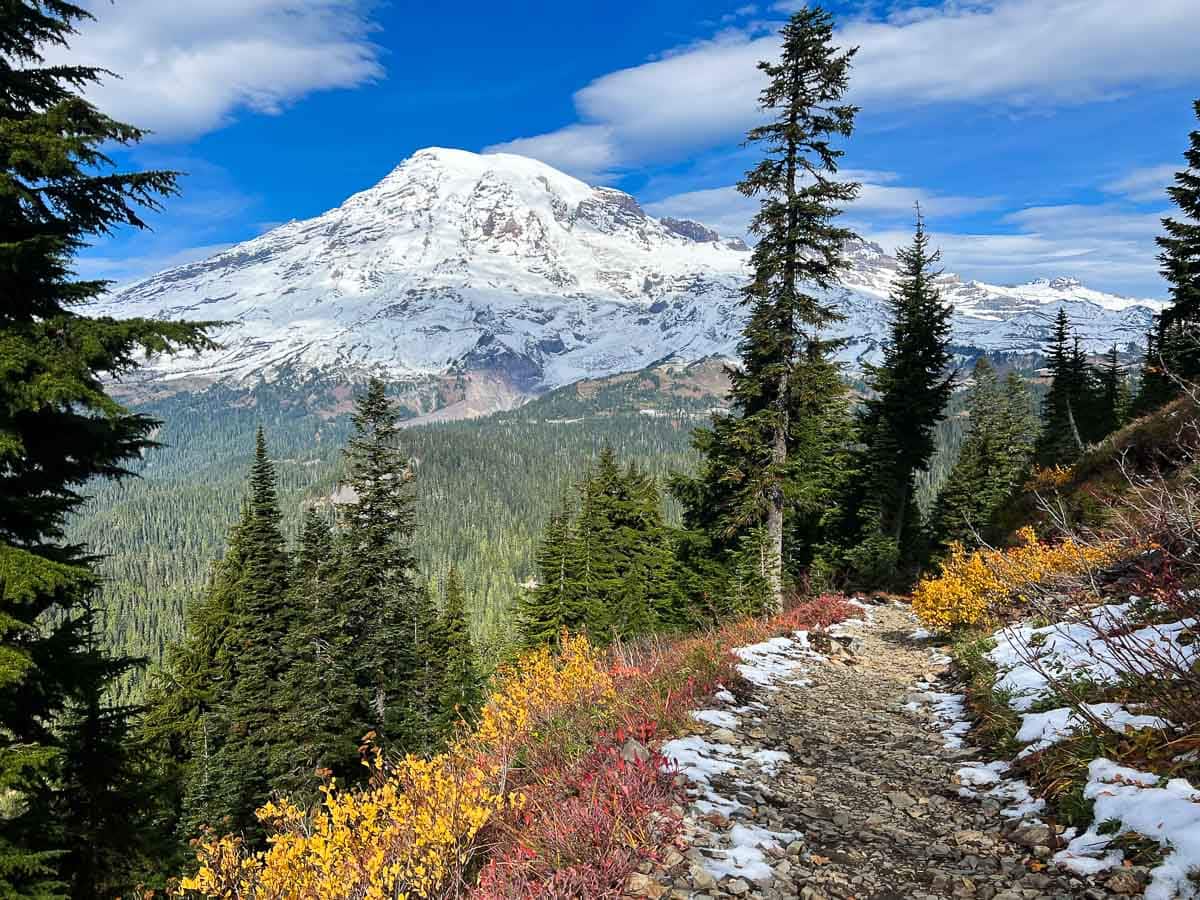
Starting across the road from the Reflection Lake, the Pinnacle Peak Trail is one of my favorite hikes in this part of Mount Rainier National Park.
This 2.5-mile roundtrip hike takes you up into the Tatoosh Range, ending at 5,920-foot-high Pinnacle Saddle, which sits between Pinnacle Peak in the northeast and Plummer Peak in the southwest.
As you climb up to the saddle, majestic Mount Rainier will be behind you most of the way. At the saddle itself, you can see Mount Adams, Mount St. Helens, and Mt. Hood toward the south. The best views of Mount Rainier are on the way back, when you’ll be directly facing the mountain. And those views are truly spectacular.
Additionally, the Pinnacle Peak Trail is a great trail to see wildlife, particularly pikas and marmots
3. Jackson Visitor Center (Paradise)
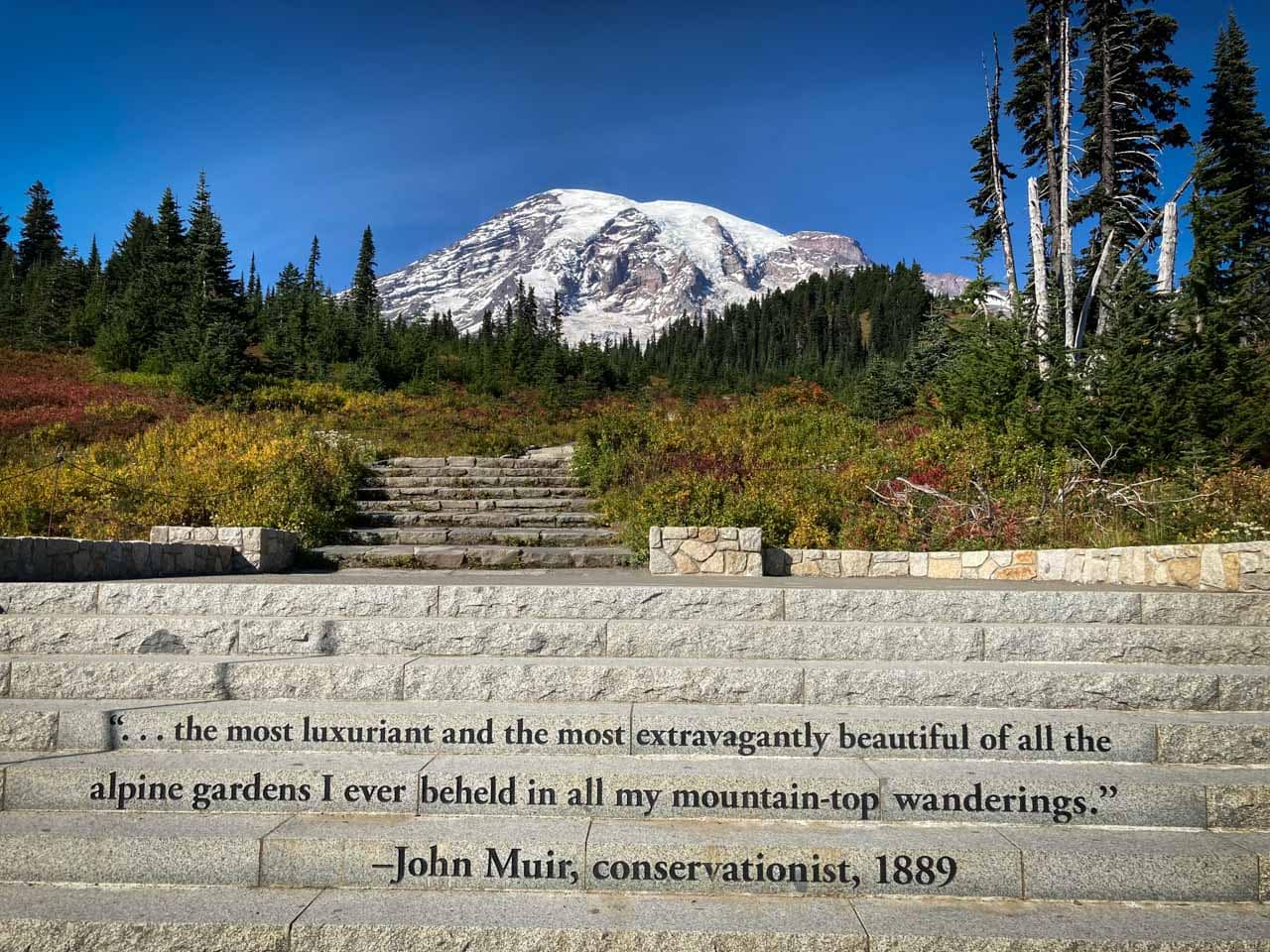
The Henry M Jackson Memorial Visitor Center at Paradise offers visitors general information, guided ranger programs, exhibits, the park film, a book and gift shop, and a cafeteria. It also provides some of the best and most accessible views of Mount Rainier.
The visitor center is the starting point for hikes to popular places like Panorama Point, Myrtle Falls and around the glorious Paradise Meadows.
The iconic view from behind the visitor center takes in the famous steps with their John Muir quote inscription, while Mount Rainier dominates the backdrop. What a view!
4. Skyline Trail (Paradise)
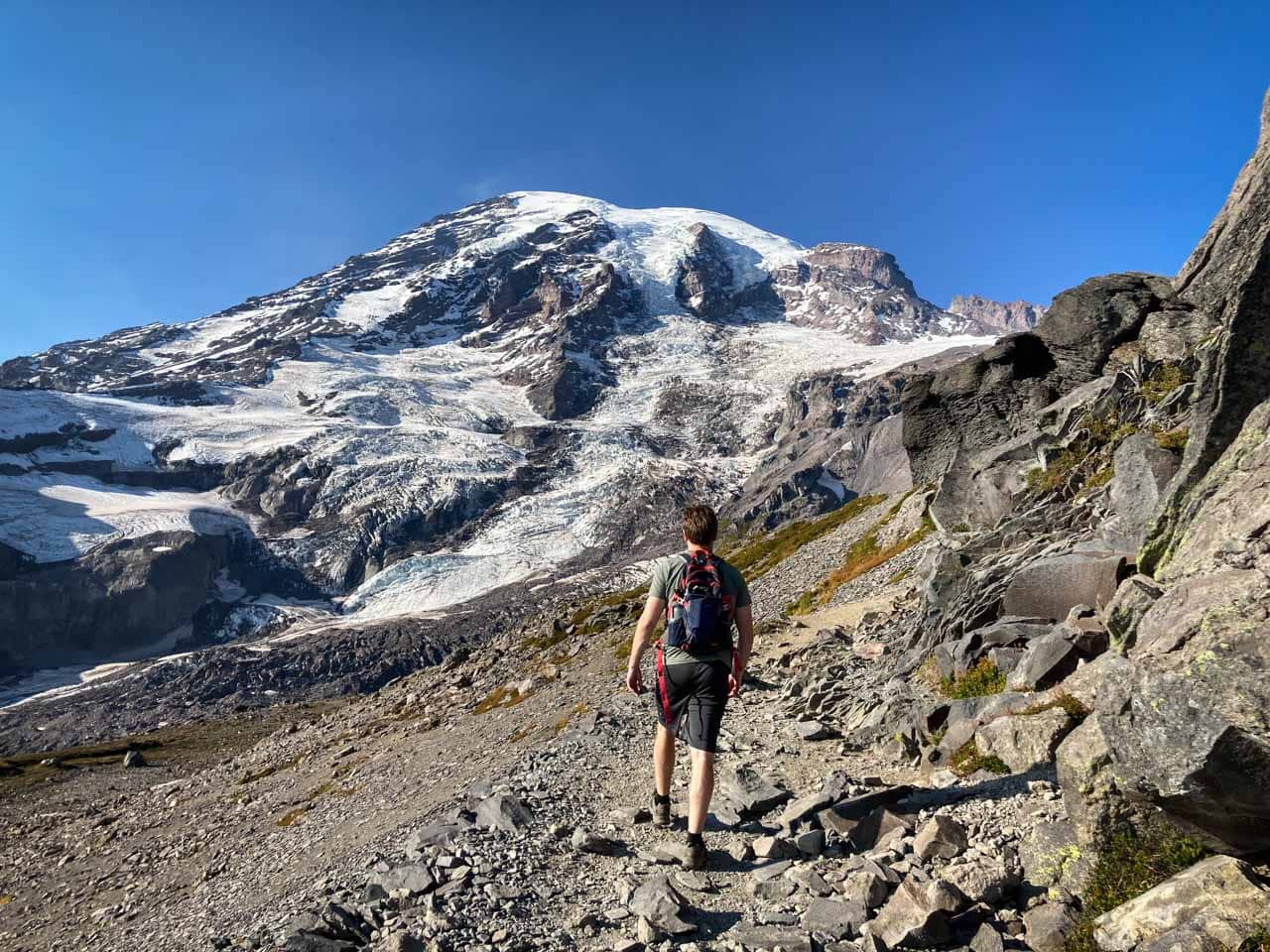
One of the most beautiful and popular places in Mount Rainier National Park, the Skyline Trail is nothing short of breathtaking.
This 5.5-mile round-trip hike starts at the Jackson Visitor Center at Paradise, just behind the beautiful historic Paradise Inn, one of the two accommodations at Mount Rainier, climbing 1,700 feet to well above the tree line.
In summer, this is one of the best areas to see wildflowers at Mount Rainier.
You’ll walk through gorgeous alpine meadows filled with all kinds of flowers, including Indian paintbrush, lupines and avalanche lilies.
In autumn at Mount Rainier, the oranges and reds of the area’s abundant berry bushes create a kaleidoscope of fall colors. Hiking the Skyline Trail is easily one of the greatest things to do at Mount Rainier in the fall. Additionally, this is also when wildlife is at its most active in the park. Watch for black bears!
Another major highlight on this hike is Panorama Point, which offers breathtaking panoramic views of the Cascade Range. The vista includes several other volcanoes, such as Mount Adams, St. Helens and even Mt. Hood all the way to the south.
As you loop around the upper Paradise area, you’ll hike below the south flank of Mount Rainier. You’ll get incredibly close to the mountain and the views of Mount Rainier are truly jaw-dropping here.
It takes about 4 hours to complete this phenomenal hike. It’s one of my absolute favorite day hikes in the national parks system.
5. Myrtle Falls (Paradise)
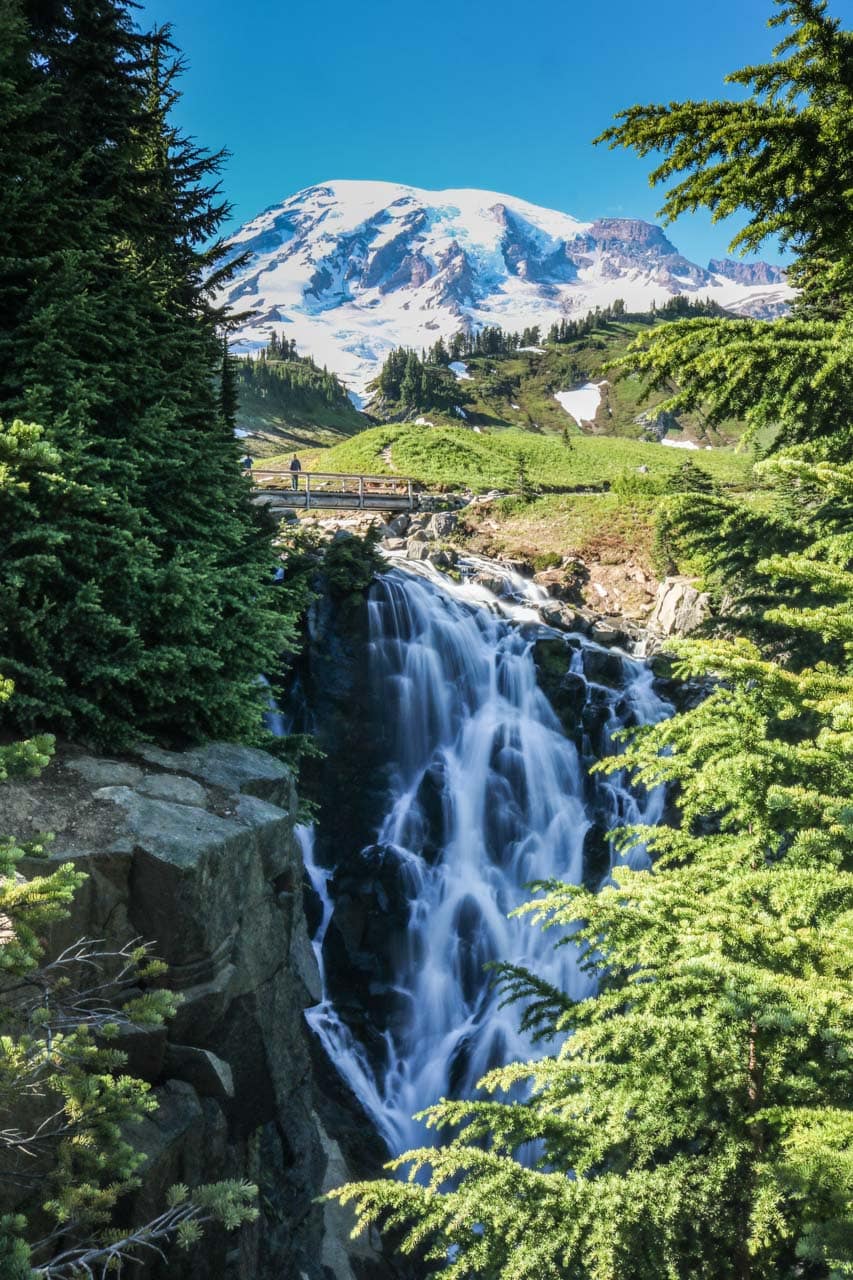
When you hike the Skyline Trail in a clockwise direction, you’ll save Myrtle Falls for a last reward. And what a treat it is!
A popular spot among photographers, Myrtle Falls in Paradise Park tumbles into a steep canyon on Edith Creek. It’s probably the most famous and photogenic of all waterfalls in Mount Rainier National Park.
What makes this Mount Rainier viewing location even more extraordinary, however, is the stunning background composed of glorious wildflower-filled meadows in summer and beautiful foliage in autumn. Massive Mount Rainier with its sprawling glaciers towers in the background.
Although technically a part of the Skyline Trail, you can also just walk to Myrtle Falls on a short, paved hiking trail from the Paradise Inn. If you don’t feel like doing a longer day hike like the Skyline Trail, the walk to Myrtle Falls is an amazing alternative.
6. Sunrise Point (Sunrise)
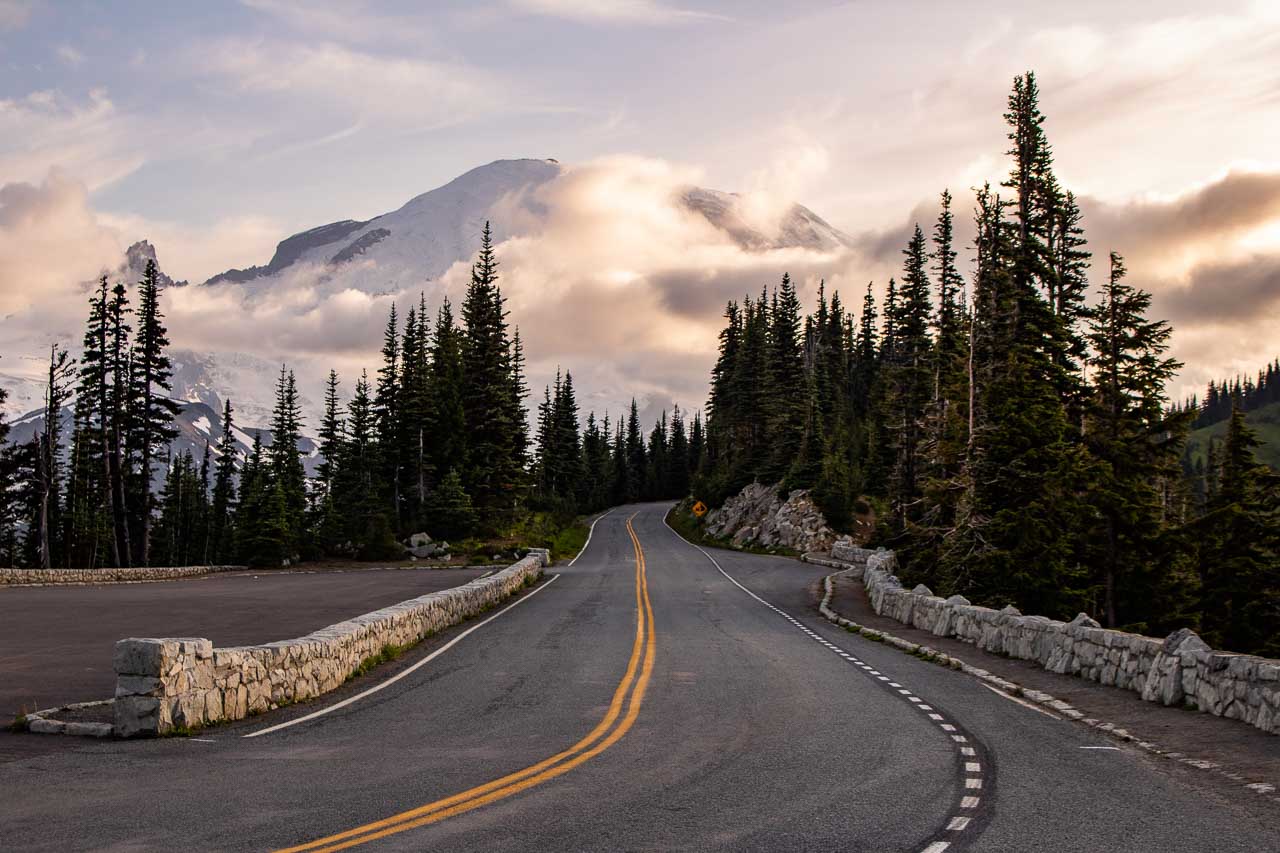
At the last switchback before the final stretch toward Sunrise, Mount Rainier’s highest vehicle-accessible point, Sunrise Point provides glorious views in all directions.
Sunrise Lake shimmers in the north, while the jagged peaks of the Cascades sweep to the east. When you look to the southwest, the enormous northeast flank of Mount Rainier blocks everything else, completing a phenomenal panorama typical of the Pacific Northwest.
There’s a large parking lot at this bend in the road, offering a stunning view of this magnificent mountain. It’s the grandest possible entrance to the beautiful Sunrise area.
7. Sourdough Ridge (Sunrise)
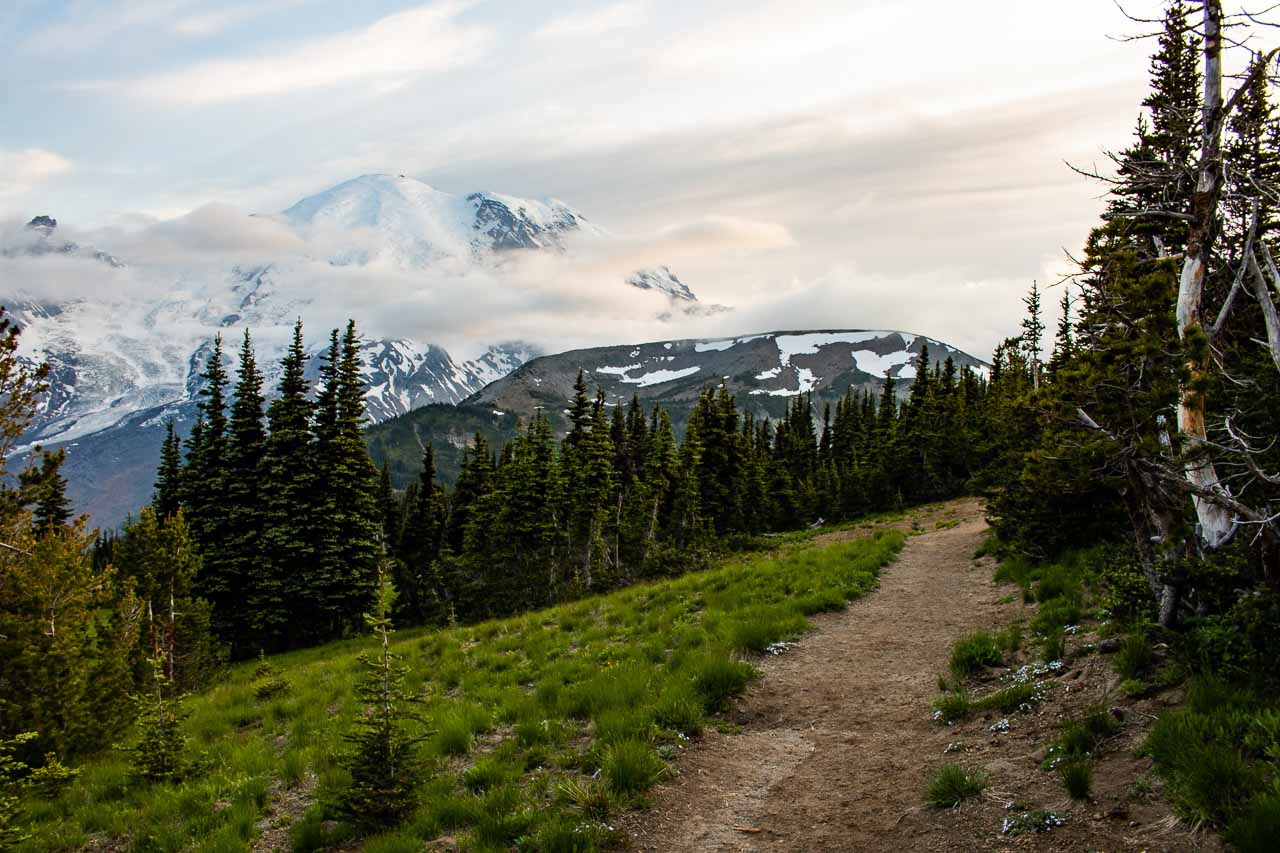
Running just above the popular Sunrise area, Sourdough Ridge offers jaw-dropping views of Mount Rainier. It’s one of my favorite hikes at Mount Rainier for subalpine wildflowers and up-close Rainier views.
The Sourdough Ridge Trail first crosses the meadows of Yakima Park and then climbs gently eastward to Dege Peak.
It’s a moderate hike—experienced hikers will say it’s easy—that offers awesome views of Mount Rainier almost the entire way. Toward the end, you’ll see other iconic Cascade mountains in the distance, including Mount Baker, Mount Adams and Glacier Peak.
As crazy busy as it is during the day, the area is surprisingly quiet and peaceful around sunset at Mount Rainier.
Dusk is also when the wild animals come out and sightings of Columbia black-tailed deer, Cascade red foxes and even black bears aren’t unusual.
8. Burroughs Mountain (Sunrise)

For up-close views of mighty Mount Rainier, few trails are better than the Burroughs Mountain Trail. Starting at the Sunrise Visitor Center, this strenuous trail is one of the best hikes in Mount Rainier to do in late-summer or early-fall for two reasons.
One, the lower elevations and meadows boast beautiful fall colors in late-September and October. And two, the higher elevations—the most accessible tundra in the Cascade Range—are free of snow this time of year.
When hiked in a counterclockwise direction, the first part of this fantastic hike is along the Sourdough Ridge Trail. Once you arrive at Frozen Lake, follow the Burroughs Mountain Trail to the top of First Burroughs Mountain.
Although the views are pretty amazing there, I encourage you to continue to Second Burroughs Mountain summit, where Rainier is breathtakingly close.
Enjoy spectacular views of the gigantic Emmons Glacier, the largest glacier in the contiguous United States, and the White River. Watch for mountain goats, which are quite common here. We saw a large group of them on a slope in the distance.
Make this a 6-mile circuit hike by taking the Sunrise Rim Trail back to the parking lot at Sunrise. On the way back, Mount Rainier views will accompany you on your right side, while beautiful meadows display vibrant summer wildflowers or fall colors all around.
9. Yakima Park (Sunrise)

There are several awesome and challenging hiking trails in Mount Rainier’s Sunrise area, but for those of you who just want a short and scenic stroll, I highly recommend the Sunrise Nature Trail.
This self-guided 1.5-mile nature trail loops through the alpine meadows behind the Sunrise Day Lodge, which are known as Yakima Park. It offers some of the best views of Mount Rainier and the Cascade Mountains beyond.
If you’re looking for a short and easy hike with clear Mount Rainier views, this trail is a fantastic option.
10. Chinook Pass / Tipsoo Lake (Chinook Pass)
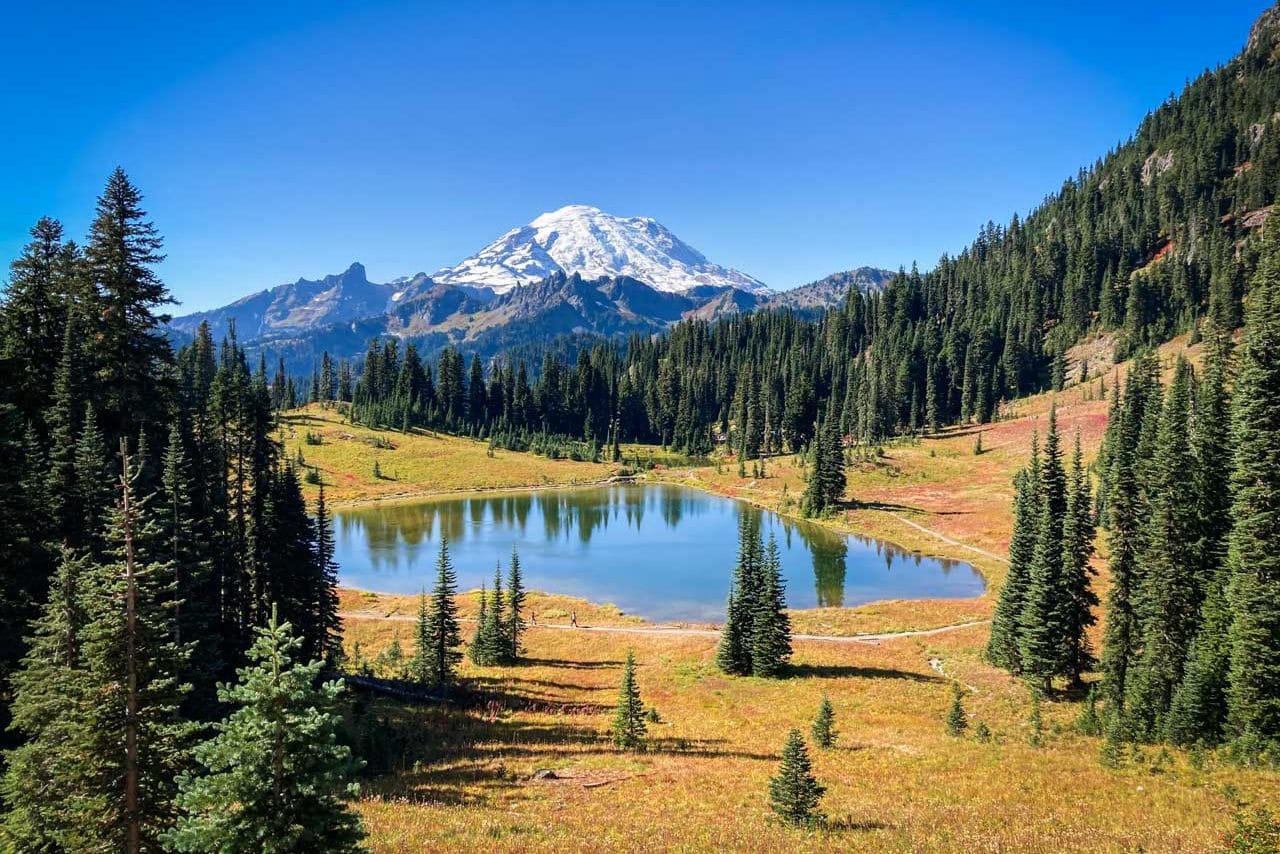
One of my favorite places in Mount Rainier National Park is Tipsoo Lake. This small and almost-impossibly beautiful alpine lake is near the summit of beautiful Chinook Pass in the eastern part of the park.
This is another location where you can enjoy the Mount Rainier wildflowers in summer. The meadows and slopes around the water abound in colors in July and August.
In fall, on the other hand, abundant huckleberries paint the landscape in beautiful reds and purples.
The view from Chinook Pass is quite possibly the greatest in the entire park—although that’s always up for discussion.
Still, it’s undeniable that the Mount Rainier views at Chinook Pass are sensational. Pretty Tipsoo Lake shimmers below, while mighty Mount Rainier rises in the background.
More Scenic Views of Mount Rainier
In addition to the epic Mount Rainier views above, there are a number of other spots that offer superb views of Rainier. Those include:
- Mildred Point (hiking trail, between Longmire and Paradise)
- Ricksecker Point (roadside overlook, between Longmire and Paradise)
- Nisqually Vista (hiking trail, Paradise)
- Mount Fremont Lookout (hiking trail, Sunrise)
- Tolmie Peak (hiking trail, Mowich Lake)
Map of the Best Views of Mount Rainier (in Mount Rainier National Park)
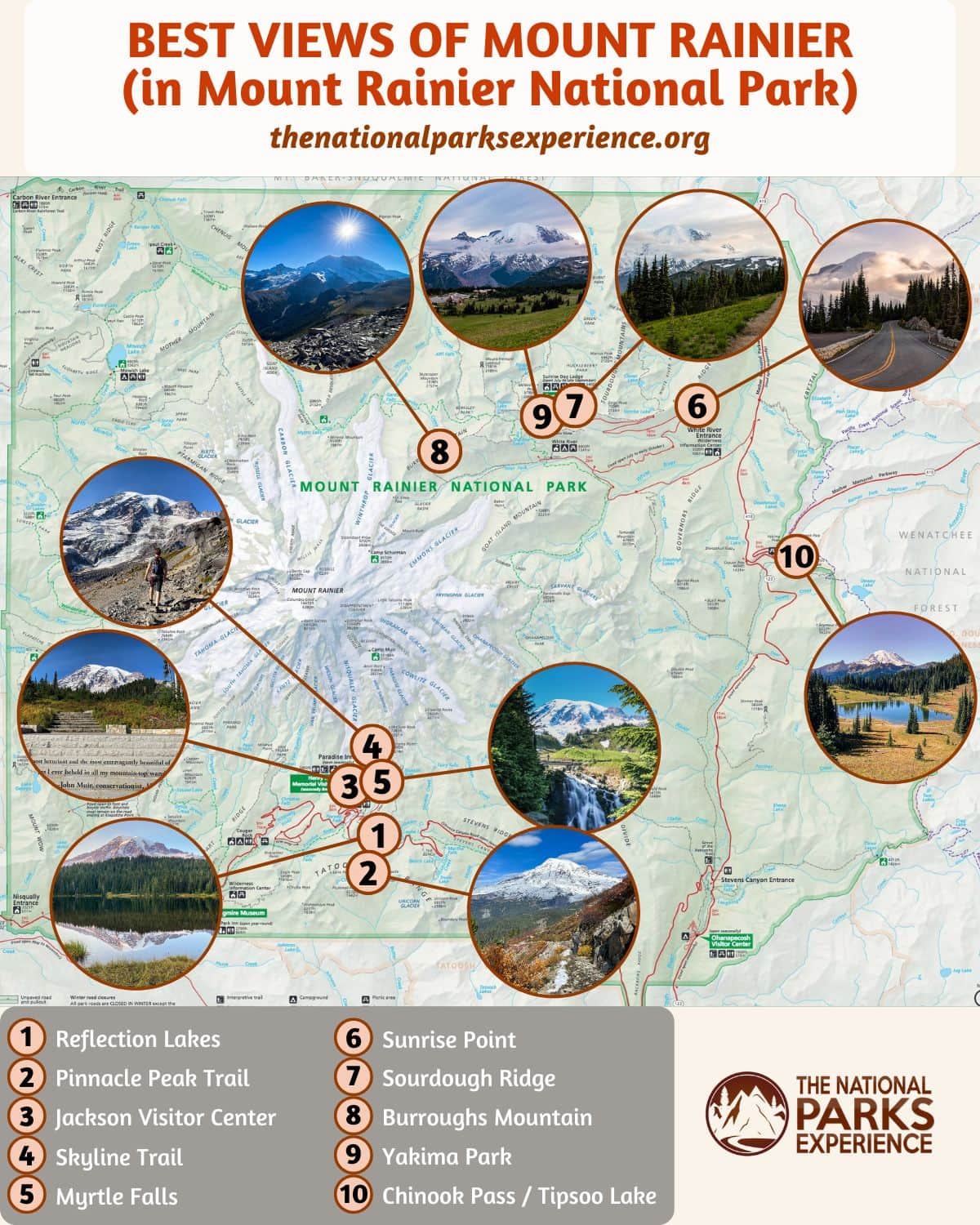
More Scenic Views in the National Parks
- 12 Best Views of the Teton Range
- 5 Stunning Views of Crater Lake
- 10 Jaw-Dropping Views in Hawai’i Volcanoes National Park
- 20 Overlooks and Summits in Shenandoah National Park
- All 16 Overlooks in Badlands National Park
- 12 Incredible Views in Acadia National Park
- 6 Scenic Views in Death Valley National Park
- 10 Best Views in Zion National Park

